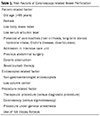Abstract
Colonoscopy is one of the most useful procedures for making the diagnosis and treating various colorectal diseases, but this procedure rarely causes serious complications such as perforation. The incidence of colon perforation during colonoscopy is low. However, as the demand for screening and surveillance colonoscopy has gradually increased and colonoscopic polypectomy has become a commoner procedure in daily clinical practice, endoscopists should pay attention to prevent and manage colonoscopy-related perforation. The purpose of this review is to briefly summarize the guidelines from the World Journal of Emergency Surgery for the management of colonoscopy-related perforation.
Figures and Tables
Fig. 1
Suggested algorithm for the management of colonoscopy-related perforation. aOpen laparotomy is necessary for treating the following conditions: very delayed surgery with diffuse peritonitis, hemodynamically unstable patients, pervious multiple surgeries and very large defects.14

References
1. Cho SB, Lee WS, Joo YE, et al. Therapeutic options for iatrogenic colon perforation: feasibility of endoscopic clip closure and predictors of the need for early surgery. Surg Endosc. 2012; 26:473–479.

2. Kim JS, Kim BW, Kim JI, et al. Endoscopic clip closure versus surgery for the treatment of iatrogenic colon perforations developed during diagnostic colonoscopy: a review of 115,285 patients. Surg Endosc. 2013; 27:501–504.

3. Panteris V, Haringsma J, Kuipers EJ. Colonoscopy perforation rate, mechanisms and outcome: from diagnostic to therapeutic colonoscopy. Endoscopy. 2009; 41:941–951.
4. Reibetanz J, Germer CT. Colonic stent as bridge to surgery versus emergency resection in patients with malignant colonic stenosis. Chirurg. 2018; 89:65.
5. Shi X, Shan Y, Yu E, et al. Lower rate of colonoscopic perforation: 110,785 patients of colonoscopy performed by colorectal surgeons in a large teaching hospital in China. Surg Endosc. 2014; 28:2309–2316.
6. Zhang YQ, Lu W, Yao LQ, et al. Laparoscopic direct suture of perforation after diagnostic colonoscopy. Int J Colorectal Dis. 2013; 28:1505–1509.

7. Cobb WS, Heniford BT, Sigmon LB, et al. Colonoscopic perforations: incidence, management, and outcomes. Am Surg. 2004; 70:750–757. discussion 757–758.
8. Iqbal CW, Chun YS, Farley DR. Colonoscopic perforations: a retrospective review. J Gastrointest Surg. 2005; 9:1229–1235. discussion 1236.

9. Iqbal CW, Cullinane DC, Schiller HJ, Sawyer MD, Zietlow SP, Farley DR. Surgical management and outcomes of 165 colonoscopic perforations from a single institution. Arch Surg. 2008; 143:701–706. discussion 706–707.
10. Lüning TH, Keemers-Gels ME, Barendregt WB, Tan AC, Rosman C. Colonoscopic perforations: a review of 30,366 patients. Surg Endosc. 2007; 21:994–997.

11. Samalavicius NE, Kazanavicius D, Lunevicius R, et al. Incidence, risk, management, and outcomes of iatrogenic full-thickness large bowel injury associated with 56,882 colonoscopies in 14 Lithuanian hospitals. Surg Endosc. 2013; 27:1628–1635.
12. Levin TR, Zhao W, Conell C, et al. Complications of colonoscopy in an integrated health care delivery system. Ann Intern Med. 2006; 145:880–886.

13. Lohsiriwat V, Sujarittanakarn S, Akaraviputh T, Lertakyamanee N, Lohsiriwat D, Kachinthorn U. Colonoscopic perforation: a report from World Gastroenterology Organization endoscopy training center in Thailand. World J Gastroenterol. 2008; 14:6722–6725.
14. de'Angelis N, Di Saverio S, Chiara O, et al. 2017 WSES guidelines for the management of iatrogenic colonoscopy perforation. World J Emerg Surg. 2018; 13:5.
15. Damore LJ 2nd, Rantis PC, Vernava AM 3rd, Longo WE. Colonoscopic perforations. etiology, diagnosis, and management. Dis Colon Rectum. 1996; 39:1308–1314.
16. Manta R, Tremolaterra F, Arezzo A, et al. Complications during colonoscopy: prevention, diagnosis, and management. Tech Coloproctol. 2015; 19:505–513.
17. Bowles CJ, Leicester R, Romaya C, Swarbrick E, Williams CB, Epstein O. A prospective study of colonoscopy practice in the UK today: are we adequately prepared for national colorectal cancer screening tomorrow? Gut. 2004; 53:277–283.

18. Rembacken B, Hassan C, Riemann JF, et al. Quality in screening colonoscopy: position statement of the European Society of Gastrointestinal Endoscopy (ESGE). Endoscopy. 2012; 44:957–968.
19. Reumkens A, Rondagh EJ, Bakker CM, Winkens B, Masclee AA, Sanduleanu S. Post-colonoscopy complications: a systematic review, time trends, and meta-analysis of population-based studies. Am J Gastroenterol. 2016; 111:1092–1101.

20. Rex DK, Schoenfeld PS, Cohen J, et al. Quality indicators for colonoscopy. Am J Gastroenterol. 2015; 110:72–90.
21. García MT, Ruano Poblador A, Galán Raposo L, Gay Fernández AM, Casal Núñez JE. Perforation after colonoscopy: our 16-year experience. Rev Esp Enferm Dig. 2007; 99:588–592.
22. Park JY, Choi PW, Jung SM, Kim NH. The outcomes of management for colonoscopic perforation: a 12-year experience at a single institute. Ann Coloproctol. 2016; 32:175–183.
23. Paspatis GA, Dumonceau JM, Barthet M, et al. Diagnosis and management of iatrogenic endoscopic perforations: European Society of Gastrointestinal Endoscopy (ESGE) position statement. Endoscopy. 2014; 46:693–711.

24. Byeon JS. Colonic perforation: can we manage it endoscopically? Clin Endosc. 2013; 46:495–499.
25. Voermans RP, Le Moine O, von Renteln D, et al. Efficacy of endoscopic closure of acute perforations of the gastrointestinal tract. Clin Gastroenterol Hepatol. 2012; 10:603–608.

26. Magdeburg R, Collet P, Post S, Kaehler G. Endoclipping of iatrogenic colonic perforation to avoid surgery. Surg Endosc. 2008; 22:1500–1504.
27. Sartelli M, Viale P, Catena F, et al. 2013 WSES guidelines for management of intra-abdominal infections. World J Emerg Surg. 2013; 8:3.
28. Di Saverio S, Patrizi F, Bassi M, Birindelli A, Nigro F, Cennamo V. Minimally invasive laparoscopic management of colonoscopic perforation avoiding laparotomy and colostomy: when and how to perform primary repair - a video vignette. Colorectal Dis. 2016; 18:817–818.
29. Semeraro N, Ammollo CT, Semeraro F, Colucci M. Sepsis, thrombosis and organ dysfunction. Thromb Res. 2012; 129:290–295.

30. Lieberman DA, Rex DK, Winawer SJ, Giardiello FM, Johnson DA, Levin TR. Guidelines for colonoscopy surveillance after screening and polypectomy: a consensus update by the US multi-society task force on colorectal cancer. Gastroenterology. 2012; 143:844–857.




 PDF
PDF ePub
ePub Citation
Citation Print
Print




 XML Download
XML Download